Passatelli in brodo
June 20th, 2008, by Francesca
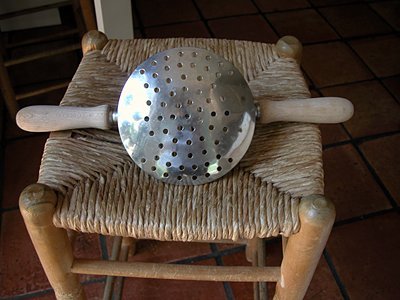
Remember the dish I picked for my interpretation of Chicken Noodle Soup a few weeks ago? That was passatelli in brodo, a typical broth dish from Romagna, more specifically from Lugo di Romagna, a small town near Faenza, where I spent most of my time growing up. I love passatelli in brodo. It's a winter dish, but if I get a twinge of homesickness or food nostalgia, I don't care what time of year it is. Call it comfort food or whatever; it's the kind of thing that just makes me feel better.
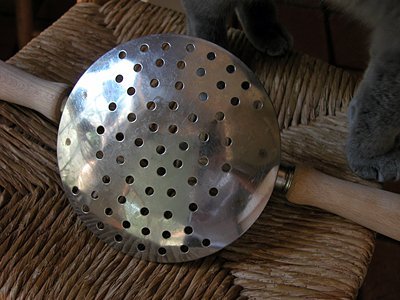
I know most of my readers are in the northern hemisphere, but at least a couple are down under (hi, Steve and Gaby!) so this might be a timely recipe for them and the rest of you can just file it away for next winter.
If it weren't for the liquid/puréed diet I am on for another couple of days, I would not have made passatelli on a day like this: 106ºF (41ºC). Yes, it's insane, but there's only so much yogurt and ice-cream I can eat in one day.
The strange looking thing in the photos above is the traditional tool used in Romagna to make passatelli, but…
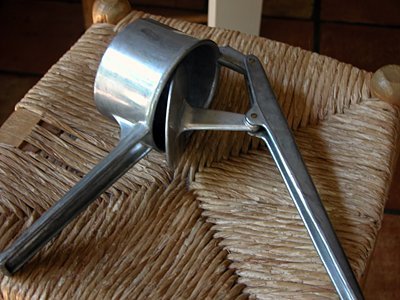
a ricer like this one will do just fine.
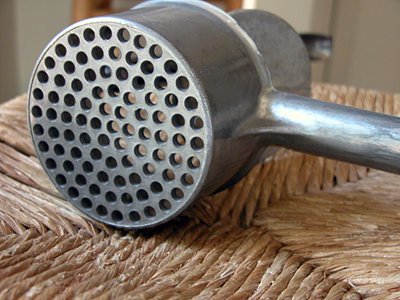
Ingredients (serves 4)
- 100 gr
- Parmesan cheese, grated
- 100 gr
- breadcrumbs, small
- 3
- eggs
- 1 lt
- chicken broth
- 30 gr
- butter
- nutmeg
- salt
- black pepper
- lemon zest (optional)
In a bowl, mix the breadcrumbs and Parmesan cheese with the melted butter, the whole eggs, a pinch of nutmeg, a big pinch of salt, the ground black pepper and the lemon zest. I've only recently started to add the lemon zest and I like the brightness it brings to the dish. I go easy on lemon zest, pepper and nutmeg.
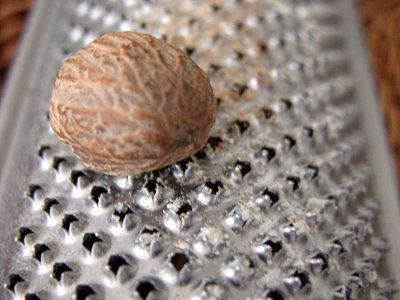
The mixture has to be rather stiff; if it’s too soft, add more breadcrumbs and Parmesan. Mine was a little too stiff this time and my little worms broke too soon. Part of the problem was that I didn't have good breadcrumbs.
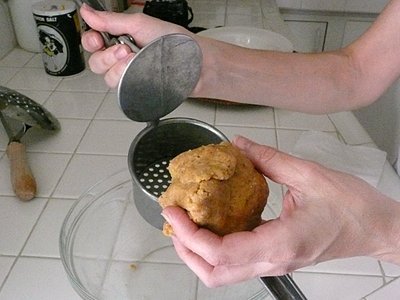
Pass the mixture through the ricer (it has to offer a good resistance) and cut the little “worms” when they are about 2 inches long. You could even do this over the boiling broth.
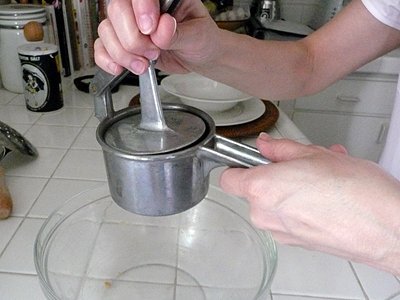

I should have dropped the passatelli on a tray and spaced them apart, but I forgot.
Bring the seasoned broth to boil in a pot, and drop the passatelli. They cook in less than 5 minutes. Serve immediately.
In the past few years, restaurants in Romagna have started to cook passatelli in broth and then drain them to serve them pasta-style with ragù or other condiments. I haven't tried them that way yet, so I don't have an opinion. Next time I go to Italy, I'll put that on my to do list.
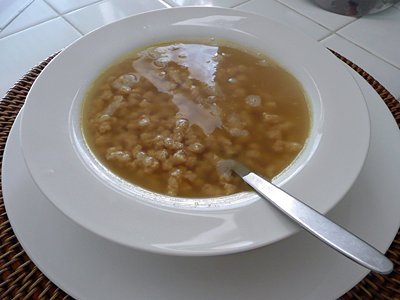
By the way, this is a dish that really benefits from a good homemade broth, and the perfect broth for it would be brodo di cappone (capon broth) or brodo di manzo e gallina (beef and hen broth). Passatelli are one of several traditional Christmas dishes in Romagna, usually followed by bollito misto, mixed boiled meat and vegetables used to make the broth. I admit that I didn't make my own broth today and the dish suffered from that.
For those of you who like their broth super clear – consommè style – this may not be your cup of tea, as the passatelli tend to cloud the broth. Like most (all?) dishes from my beloved Romagna, this is a rustic plate.
Oh, one more thing… use the best Parmigiano you can find (Parmigiano Reggiano, freshly grated) and whatever bread you choose, please don't use sourdough or you'll make me cry.
7 Responses to “Passatelli in brodo”
Sorry, comments are closed for this article.




June 20th, 2008 at 09:05 PM And Italy plays on Sunday! Hmmmm Maybe I need some soup. The receipe sounds really yummy. Hope you are on the mend and can soon have solids again. Feel better!
June 21st, 2008 at 09:32 AM Okay, why would using sourdough make you cry? It's the standard bread in this house, homemade, extra sour, half whole wheat... Also, *what* makes bread crumbs "good"? Chicken broth around here is a staple, hard enough to bounce when cold, so thick it coats the teeth. It's fuel for my old body. Will definitely try your passatelli recipe -- thanks!
June 21st, 2008 at 09:36 AM Yum. Just yum. That looks delicious enough to bother with making your own little noodles.
June 21st, 2008 at 07:17 PM looks great! Will be saving it for cabin use in the winter!
June 21st, 2008 at 08:25 PM ok, I'll put the sourdough to the side, just this once. This looks tasty!
June 22nd, 2008 at 12:29 PM Sylvia – about the sourdough… it's just me and my foreign ways. Sourdough is a very American thing, but I think of it as an acquired taste and one that I have never acquired. The taste of sourdough is so distinctive that I think it would alter the character of passatelli. My suggestion is to try the recipe with non-sourdough bread the first time to get a feel for the original/authentic version, then branch out. I'm all for variations. :)
Ah, the "good breadcrumbs". I should have known better, but grated the Parmigiano and broke the eggs before realizing that I had no breadcrumbs in the house so I had to improvise. Let's just say that defrosting frozen bread slices in the microwave oven, toasting them in a toaster, realizing they were only toasted on the outside, finishing them off in a pan and putting them in a coffee grinder is not the best way to get "good breadcrumbs".
June 22nd, 2008 at 04:36 PM
Sourdough is a point of contention in this household. Luckily, I can sneak in my life-giving bites between multi-course meals served by my personal in-house proto-chef. It’s a curse I’m willing to bear.
Francesca has always told me that sourdough is an American thing, but I always thought the French brought it over to California during the Gold Rush. I grew up outside San Francisco — famous for its sourdough, in case you don’t know — so this is an acquired taste that I have acquired. In fact, in my mind, it goes a little like this:
I’m sure I’ll find some dissent in this, but that’s the basic calculus. Francesca posited today that maybe the fact that California is only 150 years old (in its current cultural format) makes us yearn for some history, and when we eat sourdough from century-old starter it’s like we’re eating our roots. Despite the odd imagery that conjures, she might have something there.
Still, I refuse to believe that you can take good fish, gone carefully bad, and make a “fish sauce.” That’s not a taste I plan to acquire.